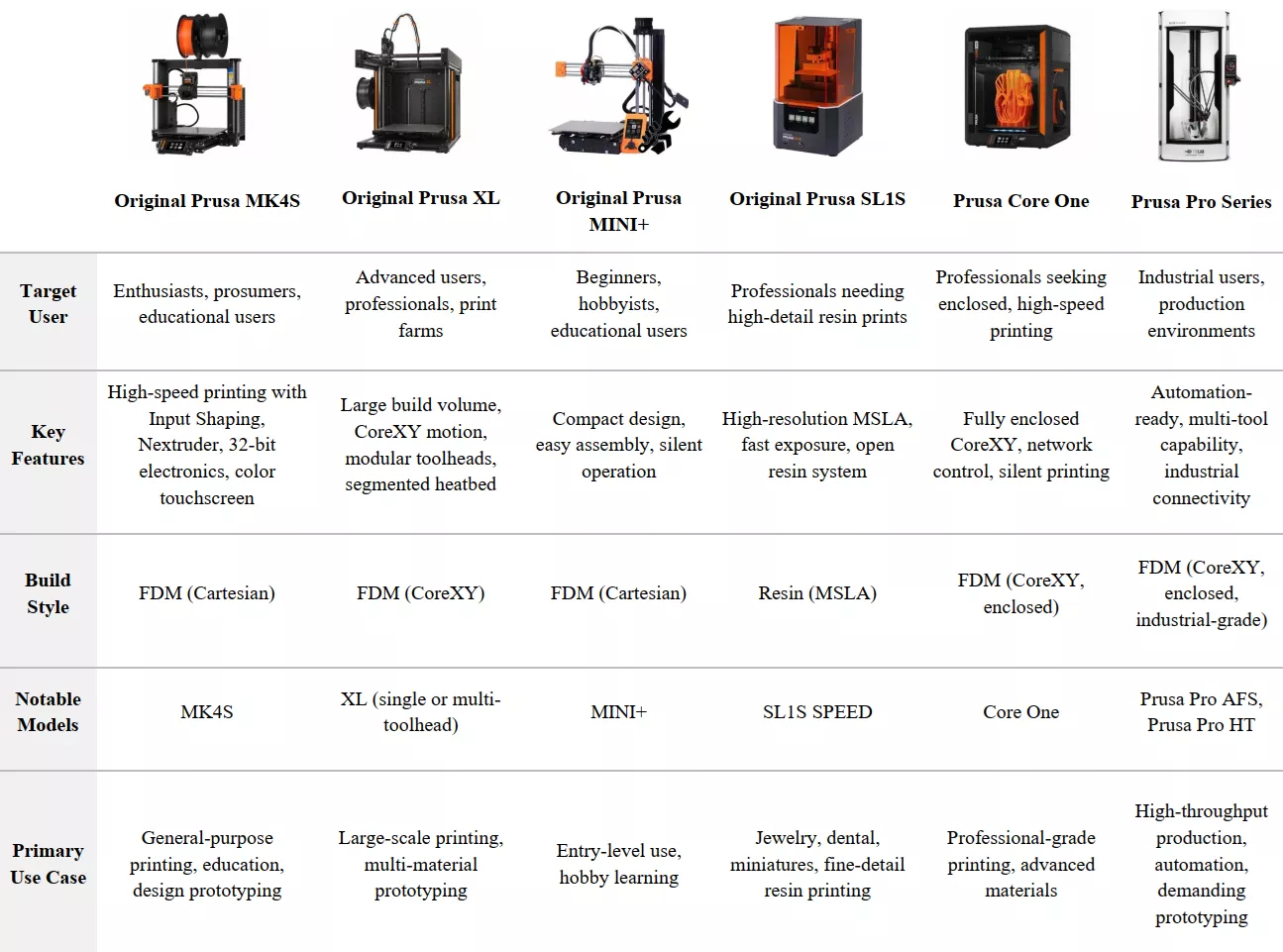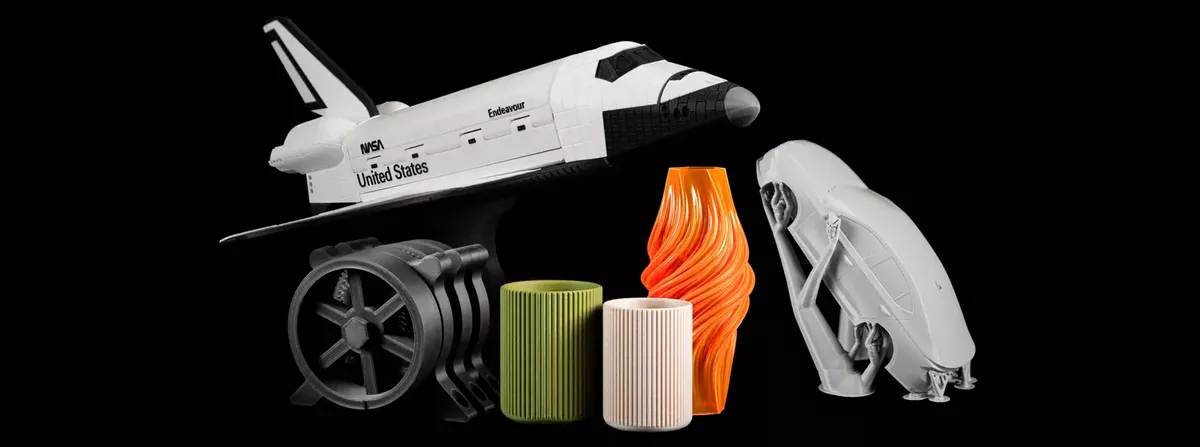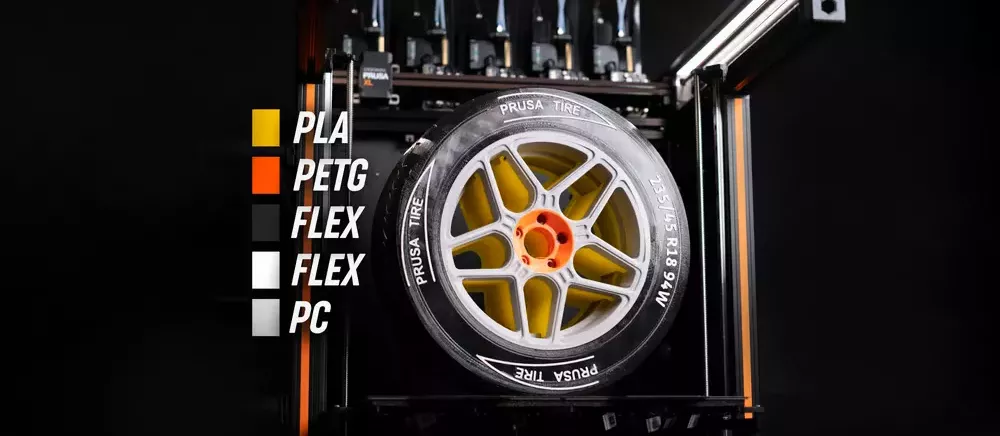Highlights
Outstanding print quality with minimal tuning needed
Extensive material compatibility with flexible, technical, and engineering-grade filaments
Strong focus on reliability and long-term durability
Fully open-source ecosystem with deep community and developer support
Excellent ease of use with semi-assembled kits and intuitive software (PrusaSlicer)
Exceptional customer support and documentation quality
Continual innovation (Prusa XL, CoreXY models, multi-material printing systems)
Higher pricing compared to budget brands but justified by consistency and service

Founded by Josef Prusa in 2012, Prusa Research has become one of the most respected names in desktop 3D printing. Starting with the open-source RepRap project (a community-driven initiative to build self-replicating 3D printers), Prusa printers quickly built a reputation for reliability, community-driven development, and outstanding customer support. Their flagship models like the Original Prusa i3 MK3S+ and now the MK4 have set industry benchmarks for quality, usability, and innovation. Prusa balances cutting-edge features with an obsessive focus on stability, long-term usability, and transparency. While priced higher than typical entry-level printers, Prusa machines are considered investments for serious users—ideal for hobbyists, educators, prototyping labs, and small businesses seeking consistent and dependable performance.
Product Selection
4.4 /5
Prusa is a premium open-source brand with a reputation for engineering excellence, reliability, and support. With models like the MK4 and XL, it’s built for users who care about print quality, longevity, and an active ecosystem.
Prusa offers a diverse range of 3D printers and related devices, each tailored to specific user needs and applications. Below is an overview of their main product series:

Ease of Use
4.8 /5
Ease of use is a hallmark of Prusa printers, even for models sold as kits. The assembly experience is aided by industry-leading documentation, with both printed and online guides that walk users through setup in a highly approachable manner. Prusa printers include advanced usability features such as automatic mesh bed leveling, crash detection (which pauses the print if abnormal head movement is detected), filament runout sensors (that halt printing when the filament ends), and power loss recovery for resuming jobs after unexpected shutdowns. Their proprietary PrusaSlicer software is regarded as one of the best in the field, striking an effective balance between beginner simplicity and professional-level control. With frequent firmware updates and a large, helpful community, Prusa printers deliver a user experience that is both robust and welcoming to all levels of expertise.
Cost & Affordability
3.3 /5
Prusa printers are priced higher than many of their Asian competitors, reflecting their premium design and long-term value. For example, the MK4 typically starts between $800–$1,100, while the Prusa XL, especially with multi-tool support, can exceed $2,000. However, these prices are often seen as justifiable by serious users due to the printers’ reliability, long lifespan, high resale value, and industry-leading support. Rather than short-term gadgets, Prusa machines are considered long-term investments—tools built to deliver consistent, high-quality results for years to come.
Print Quality & Speed
4.6 /5
Print quality is where Prusa shines brightest. Machines like the MK3S+, MK4, and XL consistently deliver flawless first layers (the crucial first printed layer that affects the rest of the print), excellent dimensional accuracy (objects match the intended size precisely), and beautiful surface finish with minimal user tuning. Prusa’s self-calibration routines (automatic checks and alignments before printing), mesh bed leveling (scanning the bed at multiple points to compensate for slight unevenness), and finely tuned slicer profiles (preset configurations in the slicing software) help ensure great results right out of the box.

In terms of speed, the traditional i3 architecture (a Cartesian-style design where the bed and print head move along fixed axes) isn't as fast as newer CoreXY systems (a motion design that allows faster, more stable movements, seen in brands like Bambu Lab), but offers unmatched reliability. The newer Prusa XL and CoreXY-based models narrow that gap by combining faster print speeds with precision and multi-tool capabilities (multiple print heads for multi-material or parallel printing).
Material Compatibility
4.5 /5
Prusa printers are built for material versatility. With E3D all-metal hotends (high-performance heating components capable of reaching ~300°C), high-temperature heated beds (for minimizing warping and improving adhesion), and advanced cooling systems, they can easily handle PLA, PETG, TPU, ABS, ASA, PC blends, and even Nylon (a tough, flexible material used in functional parts).

Thanks to their open filament policy (users can freely use any filament brand), users aren’t restricted to Prusa's own materials. However, Prusament—their in-house filament line—offers high consistency, color variety, and eco-friendly options, reinforcing their dedication to material quality.
Build Volume & Variety
4.0 /5
Prusa covers most user needs with a compact but thoughtfully structured product line. The Mini+ features a 180 × 180 × 180 mm build volume, making it suitable for small-scale parts, miniatures, and prototypes. The MK3S+ and MK4 models offer a more standard mid-size 250 × 210 × 210 mm print bed, ideal for the majority of home, school, and professional desktop use cases. For users with larger needs, the Prusa XL delivers an expansive 360 × 360 × 360 mm print volume along with modular multi-tool support, allowing multiple extruders to work independently or in tandem for advanced applications like multi-material printing. While Prusa doesn't offer the sheer number of niche formats found in some Chinese brands, its portfolio is strategically curated to deliver maximum quality and integration across the most commonly needed build sizes.
Reliability & Durability
4.7 /5
Reliability is central to Prusa’s identity. Printers such as the MK3S+ are known to operate for thousands of hours with minimal maintenance or failure. This reliability stems from a combination of rigid frame design, high-quality electronics, and tight quality control during production. Features like power recovery, sensor-based error detection, and well-engineered mechanical assemblies all contribute to their long operational lifespan. Unlike many budget-friendly alternatives, Prusa printers rarely suffer from serious hardware faults, and replacement parts are widely available and easy to install, which further enhances their durability over time.
Maintenance
4.6 /5
Maintenance on Prusa printers is generally straightforward and well-supported. Their modular design enables users to easily replace components like nozzles, print beds, and bearings without the need for advanced tools or skills. Consumable items such as PEI sheets (which serve as adhesive print surfaces), lubricants, and nozzles are commonly available and intended to be user-serviceable. Built-in diagnostic tools allow users to run self-tests that catch issues early, making troubleshooting far less daunting than on less polished platforms. Compared to lower-cost machines that often require guesswork or DIY repairs, Prusa printers stand out for their predictability and clarity in ongoing upkeep.
Technology & Features
4.5 /5
Prusa may not always be the first to introduce brand-new technologies, but it is known for delivering mature, reliable, and well-integrated features. Highlights include removable spring-steel build plates that make part removal easy and safe, a Multi-Material Upgrade (MMU) that enables printing with up to five different filaments in one job, and a modular CoreXY system in the Prusa XL that improves both speed and scalability. The company’s commitment to open development is reflected in its fully open-source firmware, which is regularly updated based on both internal improvements and community feedback. The overall hardware-software ecosystem is cohesive and refined, giving users a smooth, high-performance experience without locking them into restrictive workflows.
Conclusion
Prusa defines what desktop 3D printing can be when consistency, transparency, and user care take priority. While it may not be the cheapest or the fastest, Prusa offers a refined experience grounded in engineering excellence, community collaboration, and trusted support. Whether you're a maker, educator, or small business owner, a Prusa printer is a tool built to serve, not frustrate—delivering reliable, high-quality prints for years to come.


